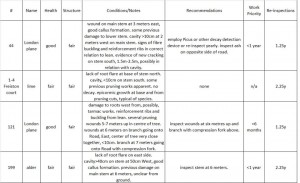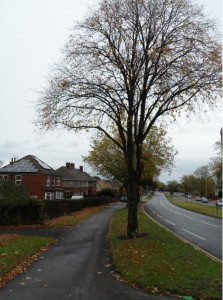Why are these trees to be felled?
I now have a report from an independent arboriculturalist on 4 of the trees that Amey want to fell on Prince of Wales Road. Here it is.
 All of the trees are in “fair” condition. This means they would need an occasional check to ensure they are still safe. It is obviously much cheaper for Amey to cut them down and replace them with saplings, which wont produce leaf litter that needs clearing or require checks. But these trees provide a valuable service to the people of Prince of Wales Road that the saplings wont provide for many years. They improve the air quality, they protect the residents from the noise of the traffic, they reduce the risk of flash flooding and they look good in an area which has little in the way of public parks and open spaces. Who takes into account the cost of losing the trees to the residents? I am still trying to find out more information about 2 more threatened trees in the area.
All of the trees are in “fair” condition. This means they would need an occasional check to ensure they are still safe. It is obviously much cheaper for Amey to cut them down and replace them with saplings, which wont produce leaf litter that needs clearing or require checks. But these trees provide a valuable service to the people of Prince of Wales Road that the saplings wont provide for many years. They improve the air quality, they protect the residents from the noise of the traffic, they reduce the risk of flash flooding and they look good in an area which has little in the way of public parks and open spaces. Who takes into account the cost of losing the trees to the residents? I am still trying to find out more information about 2 more threatened trees in the area.







Hi, no disrespect to the Arboriculturist but how can he/she judge the structural condition as fair when they have not fully investigated the extent of the defects. They have recommended a picus on one and may find its actually structurally unsafe!
Oh and callous should be ‘woundwood’ but I’m just being fussy.
Thanks Tony, I will ask him.
Island Lescure has responded to the points made by Tony Grange.
Tony Grange says:
November 4, 2015 at 4:55 pm (Edit)
Hi, no disrespect to the Arboriculturist but how can he/she judge the structural condition as fair when they have not fully investigated the extent of the defects. They have recommended a picus on one and may find its actually structurally unsafe!
Fair comment. I am only replying in regards to the London plane. Several reasons for my decision: The tree’s vitality is good, therefore if any pathogens are affecting it, the tree will be compartmentalizing the affected areas in a relatively efficient manner. This is compounded by the age of the tree, it is only semi-mature and there are no other major defects present (the older the tree, the less it is able to respond to stress as it is by then affected by many other factors). The bark around the affected areas is fresh, indicating that the cambium beneath it is alive. If the area with the decay is causing any stress to the structure of the tree, either tensile or compressive, the cambium will be stimulated to grow in response to such stress. In general the London plane is resistant to many pathogens hence the reason that it is such a popular street tree. In a year, when re-inspected, the results may change but at present I am confident with my findings.
Tony Grange says:
November 4, 2015 at 4:58 pm (Edit)
Oh and callous should be ‘woundwood’ but I’m just being fussy.
Again, fair comment. Callus becomes woundwood after several weeks or months. Even though they are sometimes/often used interchangeably, the more precise term, when you know that the growth response from a wound has been present for some time is, indeed, woundwood.
Island’s formal qualifications are:
Level 4 diploma in arboriculture (ABC Awards) obtained from Treelife ltd.
Lantra Professional Tree Inspector certificate
And then I have been working with trees since 2001 in various capacities and in different situations. Details can be found on my website (www.islandlescure.com) or on my Linkedin profile.